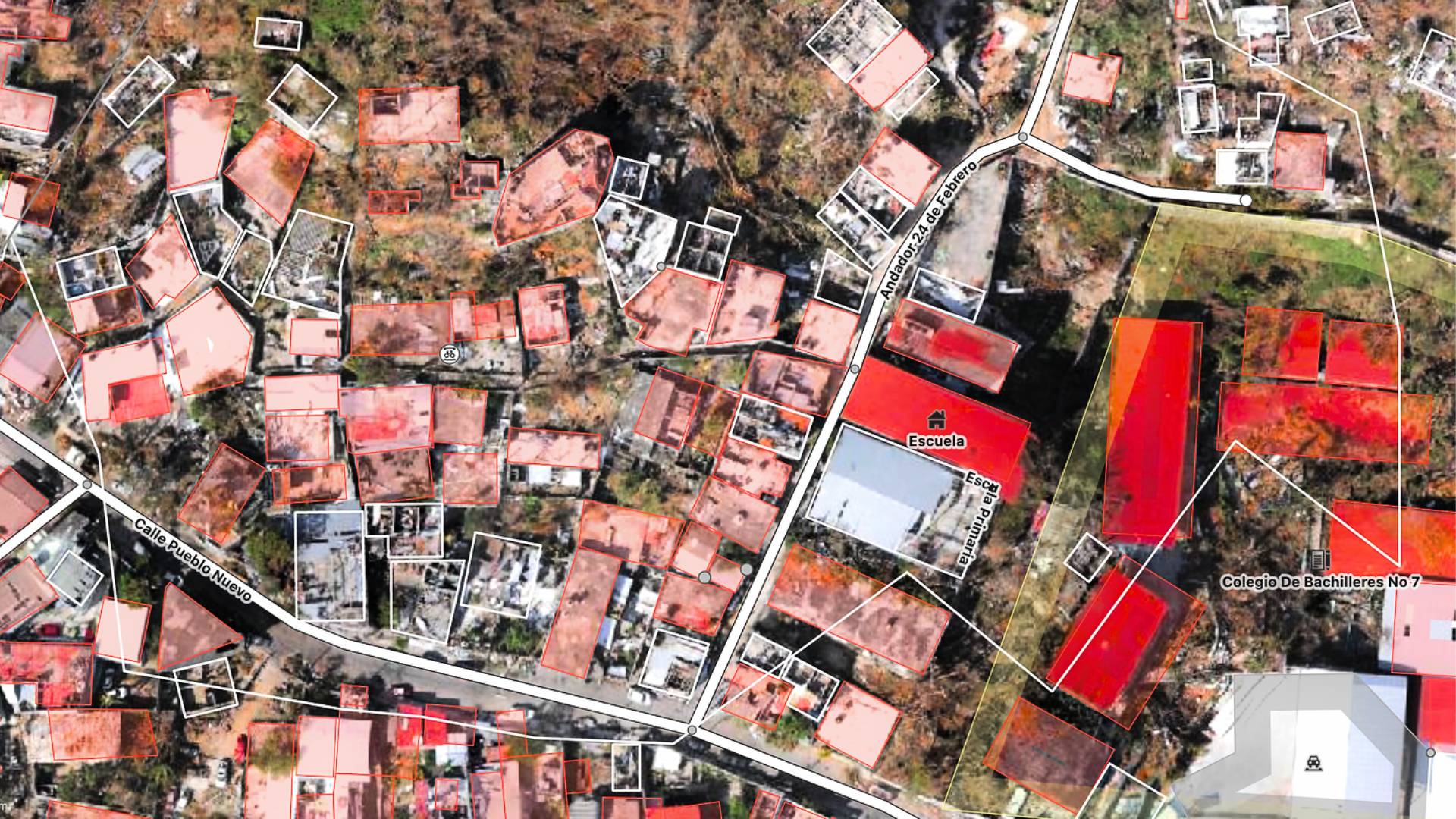Hurricane Otis 2023 Response

After Hurricane Otis struck Acapulco, HOT worked with local, national, and international partners, managing exhanges of post-disasters drone imagery and pre-desasters satelite imagery to map 52,000 buildings and identify 5,439 damaged structures. Lessons learned highlight the importance of aligning mapping with evolving response and reconstruction needs. Community-driven initiatives, backed by various stakeholders, are addressing challenges for a sustainable recovery.
CONTEXT
Hurricane Otis, a formidable Category 5 storm, struck Acapulco, Guerrero, Mexico, on October 25, 2023, unleashing devastating winds and torrential rains. This catastrophic event caused extensive damage, including the collapse of buildings and infrastructure, displacement of populations and loss of life. The aftermath left Acapulco in urgent need of comprehensive recovery efforts. The local government response, while immediate, lacked detailed geospatial data, crucial for effective reconstruction planning, and data management coordination capabilities. Recognizing this data gap, the Humanitarian OpenStreetMap Team (HOT) and community institutions initiated a project to address the critical need for accurate mapping and information. The absence of accurate geospatial data hindered targeted relief efforts, affecting the lives of those affected and the recovery of basic services and economic activity by impeding damage assessments and the efficient allocation of resources and delaying order and reconstruction efforts. The delay in operations also fostered the generalization of a complex situation of violence in the area.

Gif: NOAA Office of Satellite and Product Operations (OSPO)
APPROACH
The project use a combination of resources, including drone imagery, OpenStreetMap for general infrastructure mapping, and KoboToolbox for civil protection street operations and data collection. This multifaceted approach was made possible through collaboration with various organizations, including the National Center for Disaster Prevention, the state of Guerrero, Civil Protection, UNICEF, Help-NGO, CEMEFI, and academic institutions such as Universidad Autónoma Metropolitana Unidad Cuajimalpa, Universidad Autónoma del Estado de México, Universidad de Guanajuato, Universidad Autónoma de Ciudad Juárez, and Universidad Autónoma de Guerrero. Additionally, the project engaged chapters of Youthmappers Uamaps and UAEMex, as well as the national network of geography students, RENEG. These partnerships facilitated cross-referencing of data sources to estimate the affected population and helped in establishing a permanent network of stakeholders for Acapulco’s future reconstruction and disaster preparedness.
We’re grateful to all the volunteers for your tremendous and ongoing effort, and especially to those who led initiatives in their own groups and communities.
Despite challenges in connecting with local authorities, innovative solutions like leveraging university networks were implemented. This project underscored the importance of timely and relevant data during emergency situations and emphasized the need for effective collaboration between different sectors and data producers.
The project’s detailed mapping efforts, encompassing pre- and post-disaster buildings with a specific focus on educational institutions, health facilities, and public markets, provided a comprehensive understanding of the infrastructure landscape. Additionally, these efforts yielded estimates of affected populations, which played a crucial role in guiding targeted interventions and recovery planning.

Photo: ProtoplasmaKid / Wikimedia Commons / CC-BY-SA 4.0
OUTCOME AND IMPACT
The project successfully mapped over 52,000 buildings, 639 km of roads, and identified 5,439 damaged structures. Educational institutions, healthcare facilities, and markets were thoroughly mapped, offering a detailed inventory for informed decision-making. Ongoing efforts include estimating population affectation and collaborating on economic revitalization and reforestation projects.
As part of the outcomes, the mapping initiative covered over 700 educational institutions in Acapulco de Juárez, incorporating data from DENUE and local authorities, spanning central and peripheral locations. Additionally, 170 healthcare centers in Acapulco de Juárez and Coyuca de Benítez and all 53 public markets mentioned in the National Statistical Directory of Economic Units (DENUE) were thoroughly mapped.
.gif)
LESSONS LEARNED
Key lessons include the importance of rapid response, early coordination with imagery agencies, matching mapping efforts to changing reconstruction needs, and building lasting partnerships with local communities and authorities. Continued engagement with universities fosters a skilled volunteer base. New challenges, such as infectious outbreaks, economic recovery and reforestation, will be addressed in the future, demonstrating the project’s resilience in the post-disaster phase.
The humanitarian program of HOT’s LAC Hub is committed to long-term coordination and active participation in the reconstruction efforts in Acapulco and the early building of coordination channels with the main authorities in the different countries of the region, contributing to the resilient and sustainable reconstruction of at-risk areas.
Recent news from Hurricane Otis 2023 Response (View all news)
Coordination and Action: The Articulation of Humanitarian Mapping Response after Hurricane Otis
After Hurricane Otis in October 2023, the Hub LAC led a digital humanitarian mapping effort in Acapulco, identifying damaged structures and priority needs in collaboration with the national community and international organizations, highlighting the importance of participatory mapping and laying the groundwork for future mitigation actions through interinstitutional collaboration in building community resilience.


